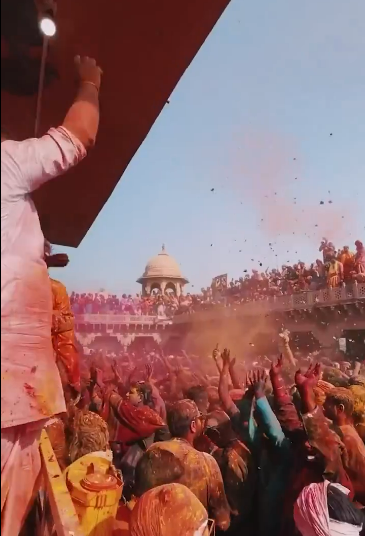Holi 2024, The festival of Holi will be celebrated with full enthusiasm by Indians living in India and abroad on Wednesday, March 25, 2024.
In India, the festival of Holi fills a lot of happiness and colors in everyone’s life, because of making people’s lives colorful, it is generally called ‘Festival of Colors‘. It brings unity and love among people. It is also called “Festival of Love”. It is a traditional and cultural Hindu festival, Which has been celebrated by the older generations since ancient times and is being followed by the new generations every year.
It is a festival of love and colors which is celebrated every year with joy and enthusiasm by the people of Hindu religion. It is a mind refreshing festival, which not only refreshes the mind but also the relationships. It is a festival which people celebrate by distributing love and affection with their family members and relatives which also strengthens their relationships. It is a festival which binds people into a bond of relationships by making them forget their old bad behavior.
In fact, it not only colors people from outside, but also colors their soul in different colors. It is not appropriate to call it an ordinary festival because it gives color to people without color. It brings a break in the normal routine of people’s busy life.
It is celebrated by Hindus of Indian origin everywhere however, it is mainly celebrated by the people of India and Nepal. It is a festive ritual in which everyone comes together to light the bonfire of Holika, sing songs and dance, with the myth that all the bad habits and evil forces are burnt away with Holika and new energy and good habits come into one’s life. Will achieve achievements. The next morning brings them great happiness which they express by coloring and gambling throughout the day.
When and Why Holi is Celebrated
According to the Hindu Calendar, Holi festival is celebrated on an annual basis in the month of March (or sometimes in the month of February) in Phalgun Purnima.
This festival also signifies the victory of good over the power of evil. It is a festival when people meet each other, laugh, forget problems and revive relationships by forgiving each other. It is celebrated with great joy on the last day of the full moon of the lunar month Phalgun, marking the beginning of the summer season and the end of the winter season. It is a festival of lots of fun and frolic activities which bind people at one place. Everyone has a big smile on their face and wear new clothes to show their happiness.
It is a grand celebration of colors, delicious foods, unity and love. Traditionally, it is celebrated as the victory of good over the power of evil or evil. It is named as “Phagwah” because it is celebrated in the Hindi month, Phalguna.
The word Holi is originated from the word “Hola” which means worship of God to get new and good harvest. Holika Dahan on the festival indicates that, those who are dear to God will be saved like the mythological character Prahlad, while those who are fed up with God’s people will one day be punished like the mythological character Holika.
There are many historical significances and legends (of mythological story in India) behind celebrating the festival of Holi. Various relics related to Holi celebration have been found on the walls of ancient Indian temples. Ahmednagar paintings and Mewar paintings are the extant varieties of medieval paintings from 16th century onwards which represent Holi celebrations during ancient times.
Holi festival is different in each state like in many states of the country. It is celebrated for three consecutive days whereas, in other different states it is a one day festival. People celebrate the first day (full moon day or Holi Purnima), by showering colored powder on other members of the household. They start the ceremony by putting some colored powder in a thali and a brass vessel filled with water. The second day of the festival is called “Punno” which means the main day of the festival, when people light Holika bonfire as per the Muhurta.
This process is celebrated in the ancient history myth of Holika and Prahlad to commemorate the victory of good over evil. The third day of the festival is called “Parva” i.e. the last day of the festival, when people come out of their homes, hug each other, apply gulal on the forehead, play with colors, dance, sing, greet each other. Meet people, eat delicious dishes and do lots of activities.
Holi is celebrated in Uttar Pradesh as ‘Lathmar Holi’ , “Phagwah” or “Deol” in Assam, “Dhol Purnima” in Bengal, “Dhol Jatra” in West Bengal, and “Fagu” in Nepal etc. Popular with names.
Holi in Mathura and Vrindavan

According to history, It is believed that Holi festival was started from the time of Radha and Krishna. Both the places are very famous for celebration in Radha and Krishna style. Some very enthusiastic people living in other regions of India especially gather in Mathura and Vrindavan to witness the colorful festival. Mathura and Vrindavan are the great lands where, Lord Krishna was born and did a lot of activities. Holi is one of them.
The festival holds the significance of love and devotion for them, where there are lots of love activities to experience and watch. This festival lasts for a whole week with a huge crowd of people from every corner of India. There is Banke-Bihari temple in Vrindavan where this grand ceremony is celebrated. Another place to celebrate Holi near Mathura is Gulal-Kund in Braj, a lake near Govardhan Mountain. To enjoy the festival, a Krishna-Leela drama is organized on a large scale.
By DNC